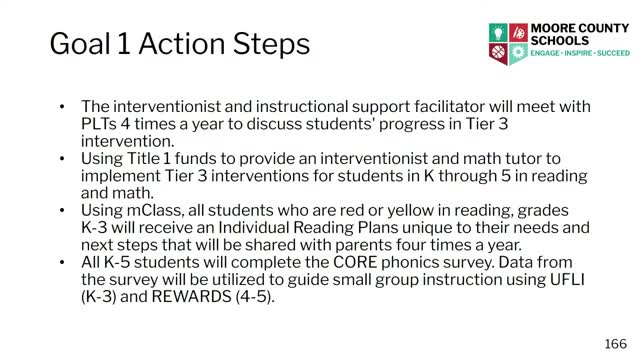Schools launch aggressive plan to close achievement gaps
October 24, 2024 | Moore County Schools, School Districts, North Carolina
This article was created by AI summarizing key points discussed. AI makes mistakes, so for full details and context, please refer to the video of the full meeting. Please report any errors so we can fix them. Report an error »

In a recent government meeting, education officials outlined a comprehensive strategy aimed at enhancing student support and closing achievement gaps within the school district. Key initiatives discussed include the implementation of tiered instructional methods and the deployment of interventionists and tutors to assist students in grades K-5, particularly in reading and math.
The district is utilizing Title 1 funds to provide dedicated interventionists who are currently working with approximately 40 to 45 students daily, focusing on Tier 3 interventions. An additional math tutor is expected to join the team shortly after the Christmas break, further bolstering support for students struggling in mathematics.
To ensure effective monitoring of student progress, the district has established regular meetings with Professional Learning Teams (PLTs) four times a year, supplemented by weekly interactions involving instructional facilitators. These facilitators are actively engaged in classroom observations and support, aiming to enhance teaching practices and student outcomes.
Data-driven approaches are central to the district's strategy, with the use of MCAS data to identify students requiring individualized reading plans. Parents are involved in this process to ensure they understand their children's progress and areas needing improvement. Additionally, all K-5 students are participating in a corephonics survey, which informs small group instruction and intervention strategies.
The meeting also highlighted a commitment to narrowing the achievement gap for students with disabilities and economically disadvantaged students. The district aims to reduce the gap for students with disabilities from 28.1% to 18.1% over the next two years, while also targeting significant reductions for economically disadvantaged and Black students.
Overall, the meeting underscored a proactive approach to educational equity, with a focus on data analysis, targeted interventions, and community involvement to foster student success.
The district is utilizing Title 1 funds to provide dedicated interventionists who are currently working with approximately 40 to 45 students daily, focusing on Tier 3 interventions. An additional math tutor is expected to join the team shortly after the Christmas break, further bolstering support for students struggling in mathematics.
To ensure effective monitoring of student progress, the district has established regular meetings with Professional Learning Teams (PLTs) four times a year, supplemented by weekly interactions involving instructional facilitators. These facilitators are actively engaged in classroom observations and support, aiming to enhance teaching practices and student outcomes.
Data-driven approaches are central to the district's strategy, with the use of MCAS data to identify students requiring individualized reading plans. Parents are involved in this process to ensure they understand their children's progress and areas needing improvement. Additionally, all K-5 students are participating in a corephonics survey, which informs small group instruction and intervention strategies.
The meeting also highlighted a commitment to narrowing the achievement gap for students with disabilities and economically disadvantaged students. The district aims to reduce the gap for students with disabilities from 28.1% to 18.1% over the next two years, while also targeting significant reductions for economically disadvantaged and Black students.
Overall, the meeting underscored a proactive approach to educational equity, with a focus on data analysis, targeted interventions, and community involvement to foster student success.
View full meeting
This article is based on a recent meeting—watch the full video and explore the complete transcript for deeper insights into the discussion.
View full meeting
